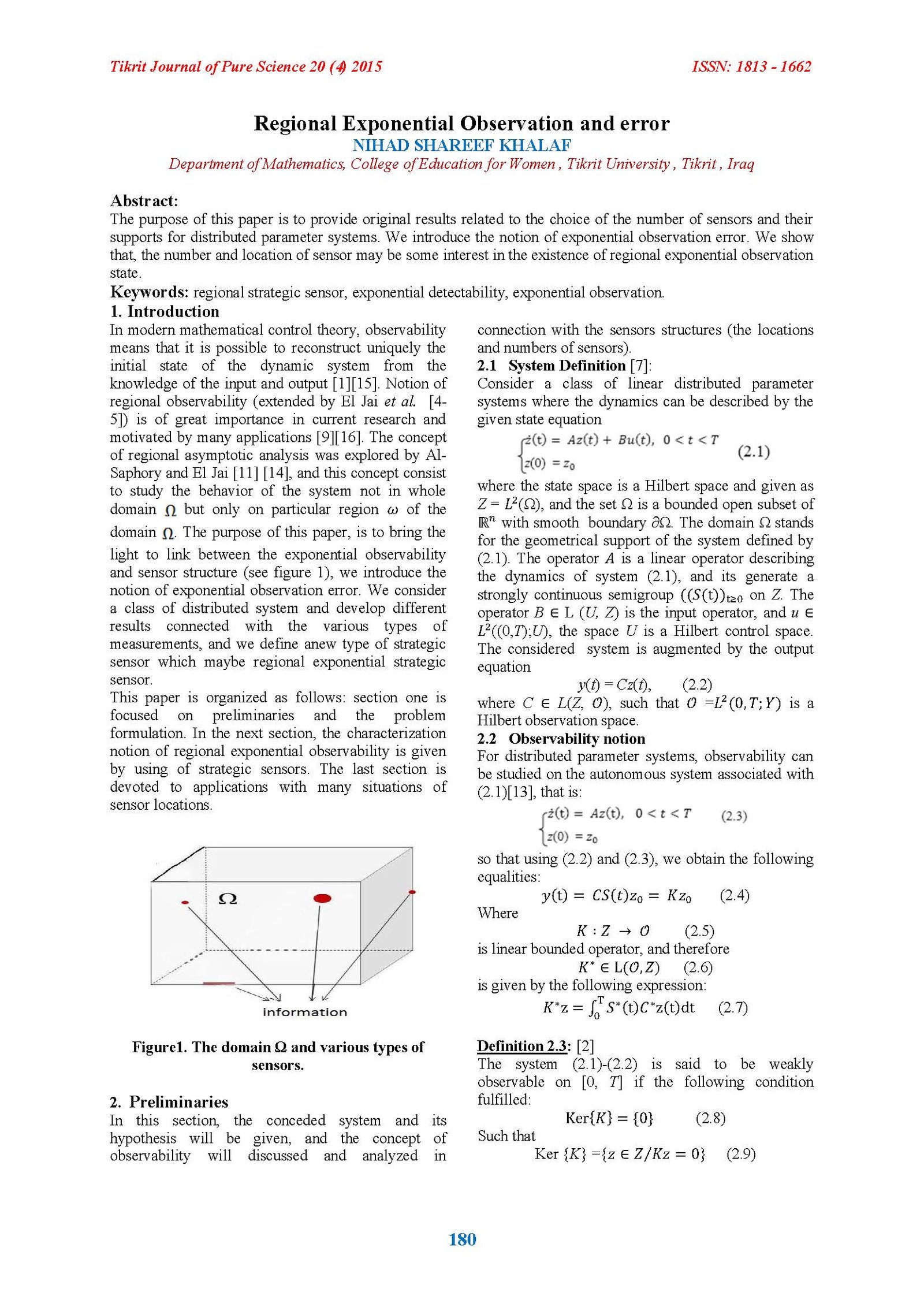Regional Exponential Observation and error
Main Article Content
Abstract
The purpose of this paper is to provide original results related to the choice of the number of sensors and their supports for distributed parameter systems. We introduce the notion of exponential observation error. We show that, the number and location of sensor may be some interest in the existence of regional exponential observation state.
Article Details

This work is licensed under a Creative Commons Attribution 4.0 International License.
Tikrit Journal of Pure Science is licensed under the Creative Commons Attribution 4.0 International License, which allows users to copy, create extracts, abstracts, and new works from the article, alter and revise the article, and make commercial use of the article (including reuse and/or resale of the article by commercial entities), provided the user gives appropriate credit (with a link to the formal publication through the relevant DOI), provides a link to the license, indicates if changes were made, and the licensor is not represented as endorsing the use made of the work. The authors hold the copyright for their published work on the Tikrit J. Pure Sci. website, while Tikrit J. Pure Sci. is responsible for appreciate citation of their work, which is released under CC-BY-4.0, enabling the unrestricted use, distribution, and reproduction of an article in any medium, provided that the original work is properly cited.
References
[1] A. El Jai and A. J. Pritchard, Sensors and actuators in distributed systems, International Journal of Control, vol. 46, no. 4, pp. 1139–1153, 1987.
[2] A. El Jai, Guisset, E.Trombe, and A. Suleiman, Application of boundary observation to a thermal systems. Conference of MTNS 2000, Perpignan, France, June 19-23, 2000.
[3] A. El Jai and H. Hamzaoui, Regional observation and sensors, International Journal of Applied Mathematics and Computer Science, vol. 19, no. 1, pp. 5 –14, 2009.
[4] A. El Jai, M. C. Simon, E. Zerrik, and M. Amouroux, Regional observability of a thermal process, IEEE Transactions on Automatic Control, vol. 40, no. 3, pp. 518–521, 1995.
[5] A. El Jai, M. C. Simon, and E. Zerrik, Regional observability and sensor structures, Sensors and Actuators A, vol. 39, no. 2, pp. 95–102, 1993.
[6] Dautray R.; Lions, J.L. Analyse mathématique et calcul numérique pour les sciences et lestechniques; série scientifique 8, Masson : Paris, 1984.
[7] E. Zerrik, H. Bourray, and A. Boutoulout, Regional boundary observability: a numerical approach, International Journal of Applied Mathematics and Computer Science, vol. 12, no. 2, pp. 143–151, 2002.
[8] E. Zerrik, L. Badraui, and A. El Jai, sensors and regional boundary state reconstruction of parabolic systems, Sensors and Actuators A, vol. 75, no. 7, pp. 102-117, 1999.
[9] J. Burns, J. Jorggaard, M. Cliff, and L. Zeietman, A PDE approach to optimization and control of high performance buildings, workshop in Numerical Techniques for Optimization Problems with PDE Constraints, No.04/2009, DOI: 10.4171/ OWR/ 2009/ 04, 25-31 January, Houston, Denmark, 2009.
[10] R. Al-Saphory and A. El Jai, Sensor structures and regional detectability of parabolic distributes systems, Sensors and Actuators A, vol. 90, no. 3, pp. 163–171, 2001.
[11] R. Al-Saphory and A. El Jai, Sensors characterizations for regional boundary detectability in distributed parameter systems, Sensors and Actuators A, vol. 94, no. 1-2, pp. 1–10, 2001.
[12] R. Al-Saphory and M Al-Joubory and M Jasim,“Regional strategic sensors characterizations” Journal of Mathematics and computational science, preprint, 2013.
[13] R. Al-Saphory,“strategic Sensors and regional exponential observability,” International Scholarly Research Network, vol. 2011, Article ID.673052, 2011.
[14] R. Al-Saphory, “Sensor structures and regional exponential observability, ”International Scholarly Research Network ISRN Applied Mathematics, Volume 2011, Article ID 673052, doi: 10.5402/ 2011/ 673052, 14 pages, 2011.
[15] R. F. Curtain and H. Zwart, An introduction to Infinite-Dimensional Linear Systems Theory, Springer, New York, NY, USA, 1995.
[16] Y. Quan, and A. Moore, Diffusion boundary determination and zone control via ,mobile actuators-sensors networks (MAS-net)-challenge and opportunities, SCOIS, Utah state university, Logan, UT84322, USA, 2004.
